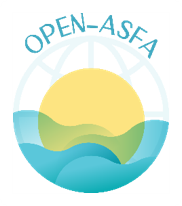Resistance profiling, evolution of biofilm formation and genetic diversity of Vibrio alginolyticus isolated from aquaculture systems
DOI:
https://doi.org/10.71754/instm.bulletin.v49.1674Keywords:
Vibrio alginolyticus, Aquaculture systems, PCR-RFLP, Antibiotic resistance, MAR, Biofilm formation, TunisiaAbstract
This study analyzes 26 presumptive Vibrio alginolyticus strains extracted from two fish farms (Khenis and Hergla, East Tunisia) that raised sea bream (Sparus aurata) and sea bass (Dicentrarchus labrax). In addition, from a shellfish farm located in Menzel Jmil, North Tunisia that raises mussels (Mytilus edulis) and oysters (Crassostrea gigas).
We have evaluated (i) the discriminatory power of PCR-RFLP for identification of closely related strains, (ii) the antibiotic resistance of the V. alginolyticus strains and (iii) their ability to form a biofilm in aquaculture farm.
Results showed that there is great heterogeneity in the diversity observed via the PCR-RFLP method related to the number of 20 genotypes generated by the two enzymes SduI and FaqI tested. The heterogeneity was observed in both fish (aquaculture farm) and bivalve (shellfish farm) origins, as well as in the same sample.
For antibiotic resistance, all isolates present a high resistance to ampicillin, erythromycin, cefotaxime, kanamycin and doxycycline. The resistance is displayed by 15 distinct profiles.
The Multiple Antibiotic resistance (MAR) index was ranged from 0.55 to 0.80 for the isolates from the aquaculture farm of Hergla followed by the index aquaculture farm of Khenis (0.55 to 0.75). While for the shellfish farm of Menzel Jmil the index ranges from 0.50 to 0.65. This finding indicated high-risk sources of antibiotic contamination in the three locations. Isolates from aquaculture systems with strong biofilm formation have been found to be resistant to antibiotics, which may allow them to survive longer in these environments.
Present findings could be relevant in aquaculture systems and underscore the importance of the linkage between adhesion, antibiotic susceptibility, and genetic diversity of these pathogenic bacteria to avoid fish and shellfish diseases. The results will provide helpful guidance on how to use antibiotics to control Vibrio alginolyticus diseases in aquaculture to be healthy.
Downloads
Downloads
Published
How to Cite
Issue
Section
ARK
License
Copyright (c) 2024 Rim LAJNEF, Miguel Angel MORIÑIGO, Abdennaceur HASSEN, Lotfi BEN ABDALLAH

This work is licensed under a Creative Commons Attribution 4.0 International License.













